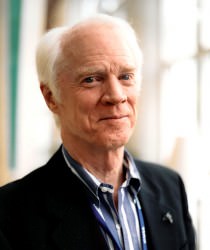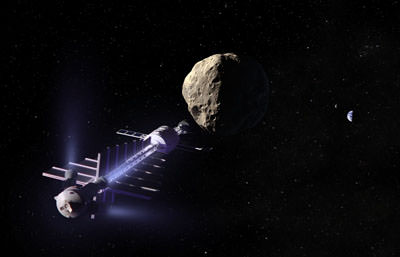If we discover an asteroid heading directly towards Earth, are we ready to deal with the challenges of either deflection strategies or an evacuation prior to impact? Apollo 9 astronaut Rusty Schweickart has spent years championing the need for the human race to prepare for what will certainly happen one day: an asteroid threat to Earth. Schweickart is Chairman of the Board of the B612 Foundation, a non-profit private foundation that supports the development and testing of a spaceflight concept to protect the Earth from future asteroid impacts, and he says we have the technology today to deal with it, but nothing has been verified or tested. “We need to mobilize that technology and achieve an international consensus on what actions should be taken,” he told Universe Today.
Schweickart also co-chairs — with another former astronaut, Tom Jones — the Planetary Defense Task Force of the NASA Advisory Council. On October 6, 2010, the Task Force submitted a list of five recommendations to the Council to suggest how NASA should organize, investigate, prepare, and lead national and international efforts defending our planet from an asteroid impact.

“Our report and recommendations are a necessary, but not sufficient element of a sequence of actions which hopefully will lead to humanity being able to prevent future asteroid impacts with Earth,” Schweickart explained. “Assuming positive action by OSTP (Office of Science and Technology Policy) and the Congress, we’ll be well on our way to preventing future impact disasters.”
The report stresses that NASA should significantly improve the ability to discover and track potential NEO impactors to allow for early detection, develop effective impact mitigation techniques, and prepare an adequate response to the range of potential impact scenarios.
These recommendations have been approved by the Advisory Council, and the report was submitted to the NASA Administrator. Then, the Office of Science and Technology Policy (OSTP) is supposed to make a decision by tomorrow – Friday, October 15, 2010 –to make assignments in the US government as to what the breakdown of work should be to protect the Earth from an asteroid impact.
Among the recommendations in the PDTF report is developing mitigation techniques. But could NASA do this type of work within their new budget? “People intuitively think that if you’re going to be pushing asteroids around, that work will take over NASA,” said Schweickart said in a phone interview with Universe Today . “Wrong. It would be a ripple in NASA’s budget, a pimple, 1.5-2.0 percent at the most of NASA’s annual budget for 10 years then dropping back to less than 0.5%. It does not displace anything else that NASA is doing. It would be a small budgetary issue, but the importance of it is huge. This saves lives, protects the global environment, and saves future generations.”
*Update (10/16/10) Schweickart asked to add to his comments about budgetary needs, as there were some misinterpretations. “I certainly did not intend that it be interpreted as no budget increment is needed! In fact our report makes very clear that we strongly recommend that Congress increment the existing budget for this purpose and not take it out of existing programs. It is not costly, but other NASA programs should not be penalized in order to support a responsible, public safety program which would amount to only a 1.5-2.0% increment in the NASA budget.”

The technology needed exists today, Schweickart said, “that is, we do not have to go into a big technology development program in order to deflect most asteroids that would pose a threat of impact. However, that technology has not been put together in a system design, and not been verified, tested or demonstrated that it could actually deflect an asteroid. So, we need to test everything – test the very sequence we would use for a deflection campaign.”
The best way to test it would be to have NASA, or perhaps a consortium of space agencies, carry out an actual mission to test the entire system.
“Not with an asteroid that threatens an impact,” said Schweickart, “but with an asteroid that is just minding its own business, and we’d have the opportunity to show we can change its orbit slightly in a controlled way.”

Schweickart said the B612 foundation, and the Association of Space Explorers (ASE; the professional organization of astronauts and cosmonauts from around the world) and every planetary defense conference held recently has discussed the need for such a capability validation.
But the recommendations made by the PDTF are, for now just suggestions, and certainly not a mandate for NASA to prepare in a meaningful way for an asteroid threat.
“There’s no official design of a deflection mission because there is no responsibility to do it,” Schweickart said. “Right now, NASA’s assignment is only to find these asteroids. Period. That’s it.”
But, with the October 15 deadline almost here, Schweickart is hopeful. “Hopefully, that will begin the process of NASA actually having this responsibility,” he said, “and that Congress will respect that and a budget be allocated in order to do the job. Then mission planners can start designing demonstration missions.”
However, if the past is any indication, any mandate wouldn’t necessarily mean a mission would happen soon.

Congress directed NASA to do the “Spaceguard” survey to find all asteroids around 40 meters and larger by 2020. “To come close to achieving that, we need to have new telescopes that will have greater capabilities than what we’ve been using to date,” said Schweickart. “Right now the Pan-STARRS telescope has the equivalent of one eye squinting, and it is not exactly knocking everybody’s socks off. LSST (Large Synoptic Survey Telescope) is still hundreds of millions of dollars before being a fully funded project.”
Schweickart said the Task Force heard presentations on perhaps better ways to complete that Congressional goal and their report indicates that at least 87% of the large asteroids whose impacts could pose a global threat to our civilization have been discovered. Right now, none pose a credible threat of a collision with Earth for the foreseeable future. But the discovery rate of the much more numerous smaller NEOs, — which represent a regional or local impact hazard — “will soon confront us with objects presenting worrisome but uncertain probabilities for a future collision with Earth. Such situations will appear more frequently as the discovery rate increases, and the nation presently has no clear policy on how to address such a situation,” the report says.
“Congress’s favorite thing to do is to tell you to do something and not give you any money for it,” Schweickart said. “That is not very responsible and it doesn’t always work and it’s not the right way a government should operate, especially where public safety is at issue. Therefore it is important that the OSTP lead the way on this issue on October 15.”
Tomorrow: What would an asteroid deflection campaign entail?
For more information:
B612 Foundation
Planetary Defense Task Force of the NASA Advisory Council


Not a cosmic disaster, just a credible, imminent threat. If we discovered that an asteroid large enough to, say, destroy a big city was likely to impact Earth in the next few years, then you would certainly see a galvanization to action that would dwarf anything we’ve done so far, and if it was an existential threat, then I have no doubt that much of the world’s resources would be piled into efforts to avert that threat (assuming we had enough warning to make a difference.)
In the long run, I’m not as worried about things falling from the skies as I am about the stuff below our feet. We’re perhaps only a couple of decades away from finding all but the smallest hazardous rocks out there, and soon after that (50 years at most) we’re going to be all but immune from asteroid and comet impacts (i.e. if we need to, we will be able to divert them).
On the other hand, we still don’t have the foggiest idea how to stop a caldera volcano (like Yellowstone) or a super-tsunami triggered by a massive underwater landslide (like Hawaii or the Canaries), both of which could happen with virtually no warning and could easily wipe out whole regions of the planet and kill billions immediately and in the aftermath.
All we can do is hope that neither of these things happens in the near future, and that in time, perhaps in a few hundred years, we’ll be in the same position as we are about to be concerning the threat from asteroids.
It will probably take a cosmic disaster to garner enough attention from the underinformed to ever get anything done? Hopefully that disaster won’t be a complete ‘show stopper’~
Preventable (in principle) natural disaster for once. But extremely low ROI, and likely no plan for keeping an actual risk management program viable over the eons needed.
The later (ROI, viability) could grow out of natural efforts to find and tug NEOs for mining and habitation purposes. Today the plan and survey effort and its multiple spin-offs (astronomical knowledge) is viable in itself, so that should be pursued in equitable competition with everything else scientific.
I think the important task now is to catalogue the ephemeris of these NEOs. From there we can get some idea of what we are looking at. If there is a problem we might also have enough of a time frame to manage the problem.
LC
Maybe we cannot deflect a asteroid at this point, we could somehow influence its orbit a bit that i crashes down on a place that is less harmful than its original trajectory.